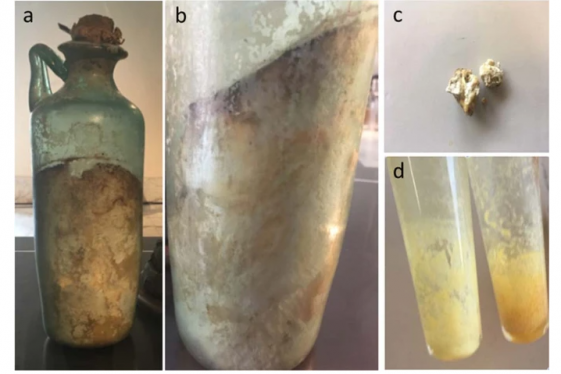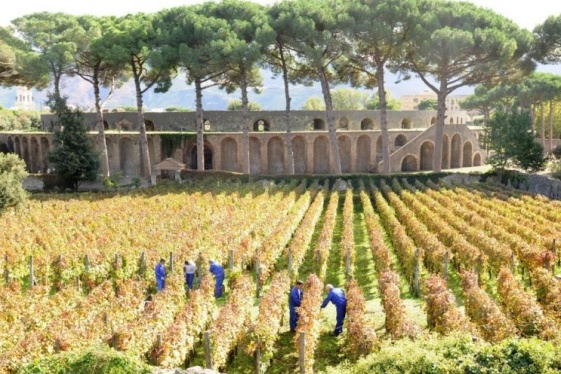Ancient ceremonial carriage uncovered by archaeologists near Pompeii
Archaeologists have unearthed a unique ancient-Roman ceremonial carriage from a villa just outside Pompeii, the Italian city buried in a volcanic eruption in 79 AD. The almost perfectly preserved four-wheeled carriage made of iron, bronze and tin was found near the stables of an ancient villa at Civita Giuliana, around 700 meters north of the walls...
READ MORERome's Colosseum hosts Pompeii exhibition
The Colosseum hosts an exhibition highlighting the history of the long-standing relationship between Rome and Pompeii, on display until 9 May.The exhibition, titled Pompeii 79 AD. A Roman story, is hailed as "unprecedented" and is held on the second tier of the Colosseum. The ancient amphitheatre recently reopened to the public, from Monday to Frid...
READ MOREPompeii shows off treasures, sorcerer's magic charms
Decades worth of archaeological finds went on public display Monday in Pompeii, shedding further light on the ancient Roman city destroyed by a volcanic eruption nearly 2,000 years ago. One is a sorcerer's toolbox including dozens of amulets, rings, statuettes and other good luck charms made of ivory, bronze, glazed ceramics and amber -- that were...
READ MOREItaly: Pompeii's Alexander Mosaic to be restored
Pompeii's celebrated mosaic of Alexander the Great's victory over King Darius III of Persia is to undergo a major restoration project at the National Archaeological Museum of Naples (MANN). The restoration of the monumental mosaic, which was rediscovered at the House of the Faun in Pompeii in 1831, will begin at the end of this month and is expecte...
READ MOREExceptionally well-preserved snack bar unearthed in Pompeii
Researchers said on Saturday they had discovered a frescoed thermopolium or fast-food counter in an exceptional state of preservation in Pompeii. The ornate snack bar, decorated with polychrome patterns and frozen by volcanic ash, was partially exhumed last year but archaeologists extended work on the site to reveal it in its full glory. Pompeii wa...
READ MOREPompeii dig reveals ‘almost perfect’ remains of a master and his slave
The almost perfectly preserved remains of two men have been unearthed in an extraordinary discovery in the ancient Roman city of Pompeii. The bodies of what are thought to be a wealthy man and his slave, believed to have died as they were fleeing the catastrophic eruption of Mount Vesuvius in AD79, were found during excavations at a villa in the ou...
READ MOREOlive oil from the 79 A.D. Vesuvius eruption stored at the Naples National Archaeological Museum (Italy)
Using a range of chromatographic, spectroscopic, and mass spectrometric analytical techniques, we characterized one of the “edible items” found at the Vesuvius archeological sites and guarded at the National Archaeological Museum of Naples (MANN) in Naples, Italy. We authenticated the specimen contained in a glass bottle (Mann-S1 sample) as origina...
READ MORESandra Hurt’s Priestess of Pompeii
Congratulations to NIAF Member Sandra Hurt for her new book, Priestess of Pompeii, an epic yet intimate portrayal of Rufilla Istacidia’s world in ancient Pompeii and Greece. Mythology and history intertwine, like the inner and outer worlds of life. Whether on the pirate-infested seas, in the quiet of sacred sanctuaries, inside Julius Caesar’s polit...
READ MOREPompeii grape harvest amid ancient Roman ruins
Grape harvest used to reproduce the wine grown in Pompeii before it was buried in volcanic ash 2,000 years ago. The annual vendemmia, or grape harvest, gets underway today in the ancient Roman ruins of Pompeii. The traditional grape harvest is part of an ongoing project, now in its 21st year, to reproduce the wine grown in Pompeii before the city w...
READ MOREPompeii unveils new hidden secrets
Pompeii was the first Italian archaeological site to reopen to the public after the coronavirus shutdown. The first visitors after the three-month closure were welcomed on 26 May, with initial access only through the Amphitheatre entrance for small groups following strict one-way itineraries. Since 9 June the rules have relaxed somewhat, with the p...
READ MORE














